1993 CADILLAC FLEETWOOD tires
[x] Cancel search: tiresPage 9 of 386

Downloaded from www.Manualslib.com manuals search engine c
c-
For the 1948 model, Cadillac
introduced the I
which set the trend in automotive
styling €or nearly two decades.
This
was followed by the 1949 model with
the two door hardtop Coupe DeVille
and the modern overhead valve,
high compression V8 engine.
Engineering innovations, con-
veniences and styling dominated the
'50s and '60s. Cruise control, auto-
matic climate control,
tilt and
telescoping steering wheels, twilight
sentinel and four door hard tops
all
debuted in these years. In 1957 the
Eldorado Brougham featured
ad-
vances such as air suspension, mem-
ory seat, automatic electric door
locks, transistor radio,
a brushed stainless steel
roof and low profile
tires.
introduced
in
1953, was redesigned for 1967 as the
first front wheel drive personal lux-
ury car. The
472 cu. in. V8 engine
used
in all Cadillacs in 1968 and
1969 was enlarged to 500 cu. in. €or
all 1970 Eldorados.
An Air Cushion Restraint Sys-
tem (airbag) was available for
1974,
1975 and 1976 Cadillacs.
Analog Electronic Fuel Injec-
tion was available, on
1975 Cadillacs
and was standard on the new inter-
national size 1976 Seville. In
1978,
the Trip Computer option incor-
porated an on-board microprocessor.
Page 132 of 386
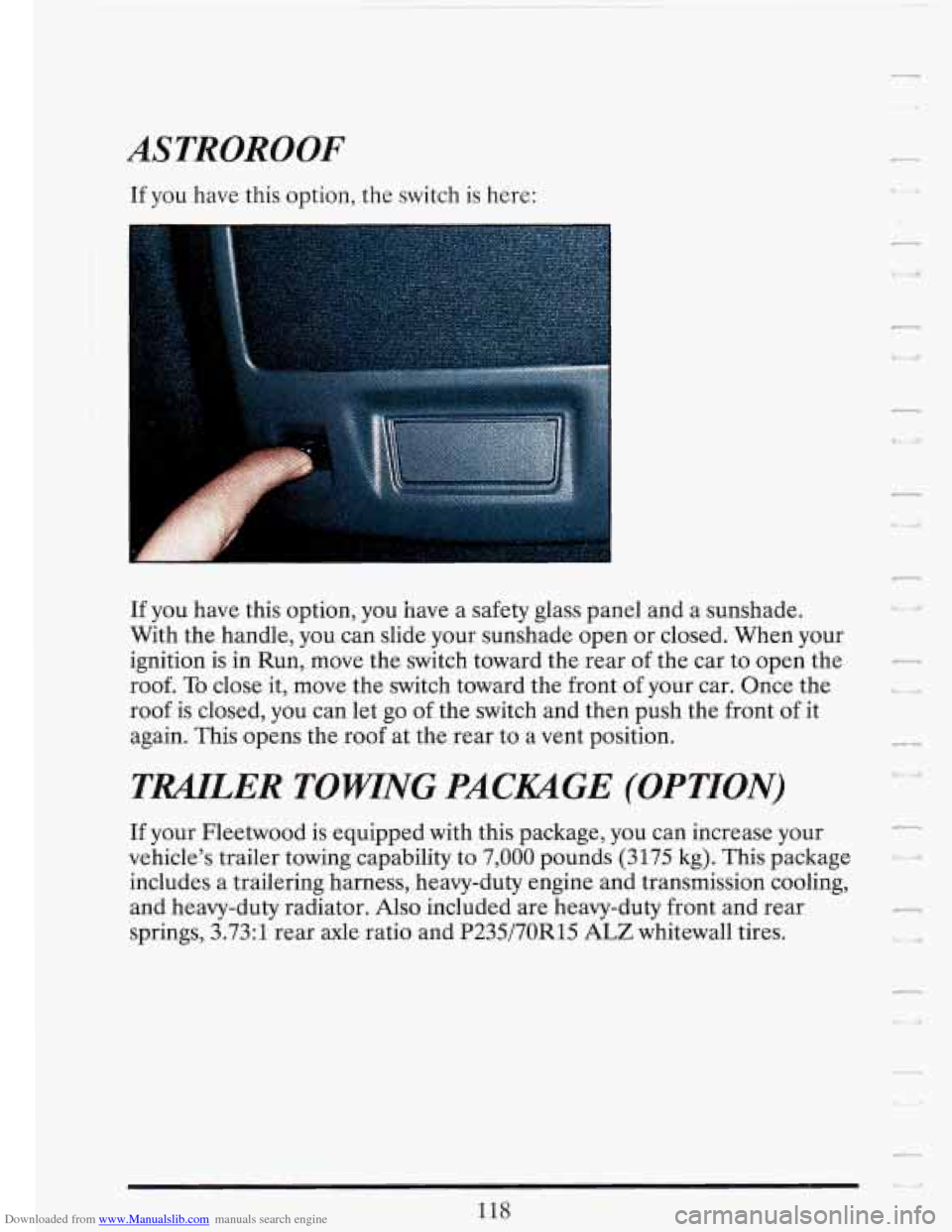
Downloaded from www.Manualslib.com manuals search engine ASTROROOF
If you have this option, the switch is here:
_.
If you have this option, you have a safety glass panel and a sunshade.
With the handle, you can slide your sunshade open or closed. When your
ignition is
in Run, move the switch toward the rear of the car to open the
roof.
To close it, move the switch toward the front of your car. Once the
roof is closed, you can let
go of the switch and then push the front of it
again. This opens the roof at the rear to a vent position.
TWLER TOWING PACKAGE (OPTION)
If your Fleetwood is equipped with this package, you can increase your 7
vehicle's trailer towing capability to 7,000 pounds (3175 kg). This package '
includes a trailering harness, heavy-duty engine and transmission cooling,
and heavy-duty radiator.
Also included are heavy-duty front and rear
springs, 3.73:l rear axle ratio and P235/70R15
ALZ whitewall tires.
7
n
Page 142 of 386

Downloaded from www.Manualslib.com manuals search engine A CAUTION:
If you let your tires spin at high speed when the “Ikaction
Disabled” light comes on, your tires can explode and you or
others could be injured. And, spinning your tires with this light
on can cause the automatic transmission to overheat or can
cause other problems that could cause an engine fire or other
damage. When you’re stuck, spin the wheels as little as possible.
If your vehicle is stuck, don’t spin the wheels above 35 mph (55
h/h) a 1 on the speedometer.
Engine Coolant Temperature Warning Light
h
T
This light tells you that
your engine coolant has
overheated.
If you have
been operating your
vehicle under normal
driving conditions,
you
should pull off the
road, stop your vehicle
and turn the engine
off
as soon as possible.
P
L 4.
-
u c
128
Page 184 of 386

Downloaded from www.Manualslib.com manuals search engine “I’ll be careful’’ isn’t the right answer. What if there’s an emergency, a
need to take sudden action, as when a child darts into the street?
A
person with a higher BAC might not be able to react quickly enough to
avoid the collision.
There’s something else about drinking and driving that many people
don’t know. Medical research shows that alcohol in a person’s system can
make crash injuries worse. That’s especially true for brain, spinal cord
and heart injuries. That means that
if anyone who has been drinking --
driver or passenger -- is in a crash, the chance of being killed or
permanently disabled is higher than
if that person had not been drinking.
And we’ve already seen that the chance of a crash itself is higher for
drinking drivers.
A CAUTION:
Drinking and then driving is very dangerous. Your reflexes,
perceptions, and judgment will be affected by even a small
amount of alcohol. You could have a serious
-- or even fatal --
accident if you drive after drinking. Please don’t drink and drive
or ride with
a driver who has been drinking. Ride home in a cab;
or if you’re with a group, designate a driver who will not drink. I
CONTROL OF A VEHICLE
You have three systems that make your vehicle go where you want it to
go. They are the brakes, the steering and the accelerator.
All three
systems have to do their work at the places where the tires meet the road.
11
d
a ,’ d
170
Page 185 of 386
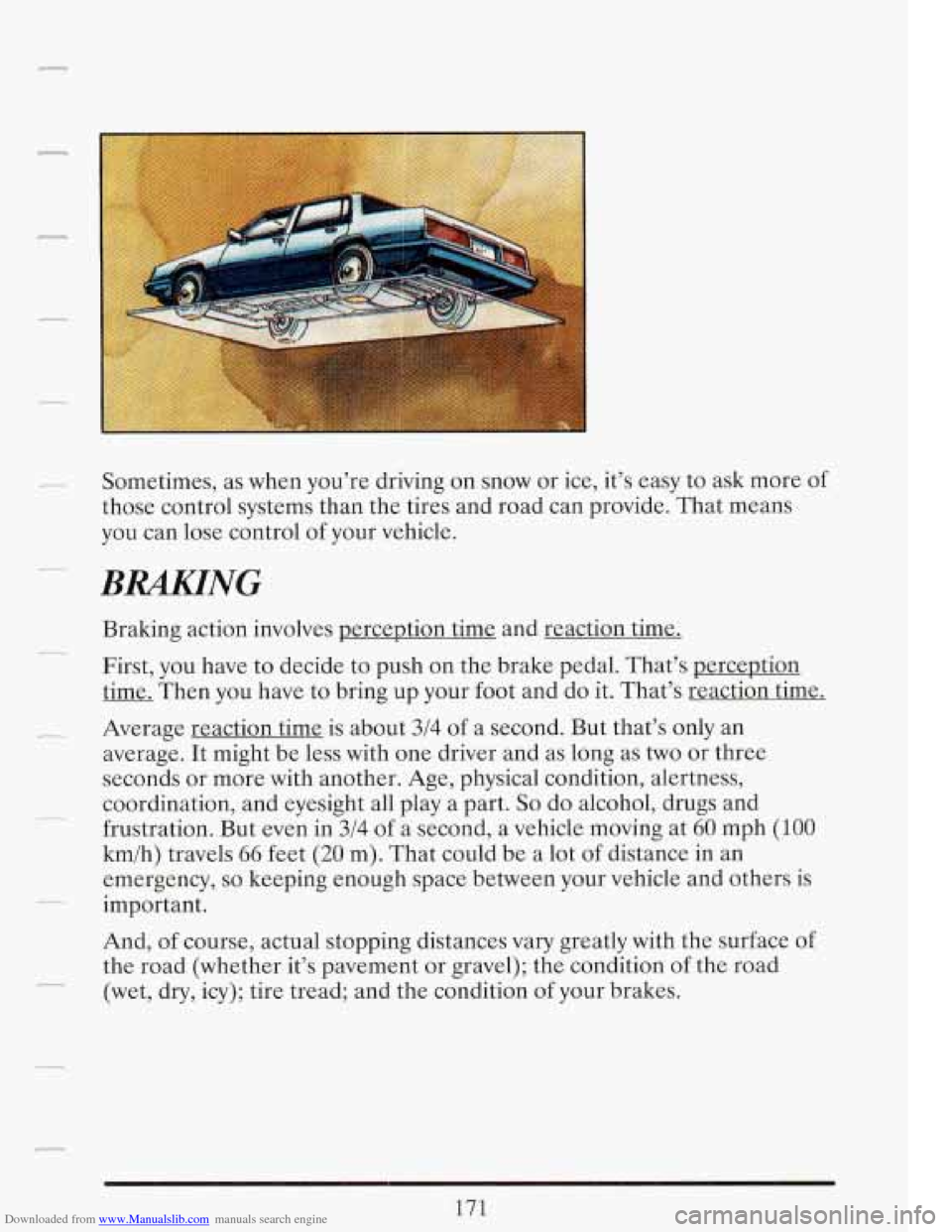
Downloaded from www.Manualslib.com manuals search engine Sometimes, as when you’re driving on snow or ice, it’s easy to ask more of
those control systems than the tires and road can provide. That means
you can lose control
of your vehicle.
BWNG
Braking action involves perception time and reaction time.
First, you have to decide to push on the brake pedal. That’s perception
time. Then you have
to bring up your foot and do it. That’s reaction time.
Average reaction time
is about 3/4 of a second. But that’s only an
average. It might be less with one driver and as long as two or three
seconds or more with another. Age, physical condition, alertness,
coordination, and eyesight all play a part.
So do alcohol, drugs and
frustration. But
even in 3/4 of a second, a vehicle moving at 60 mph (100
km/h) travels 66 feet (20 m). That could be a lot of distance in an
emergency,
so keeping enough space between your vehicle and others is
important.
And, of course, actual stopping distances vary greatly with the surface
of
the road (whether it’s pavement or gravel); the condition of the road
(wet, dry, icy); tire tread; and the condition of your brakes.
171
Page 192 of 386
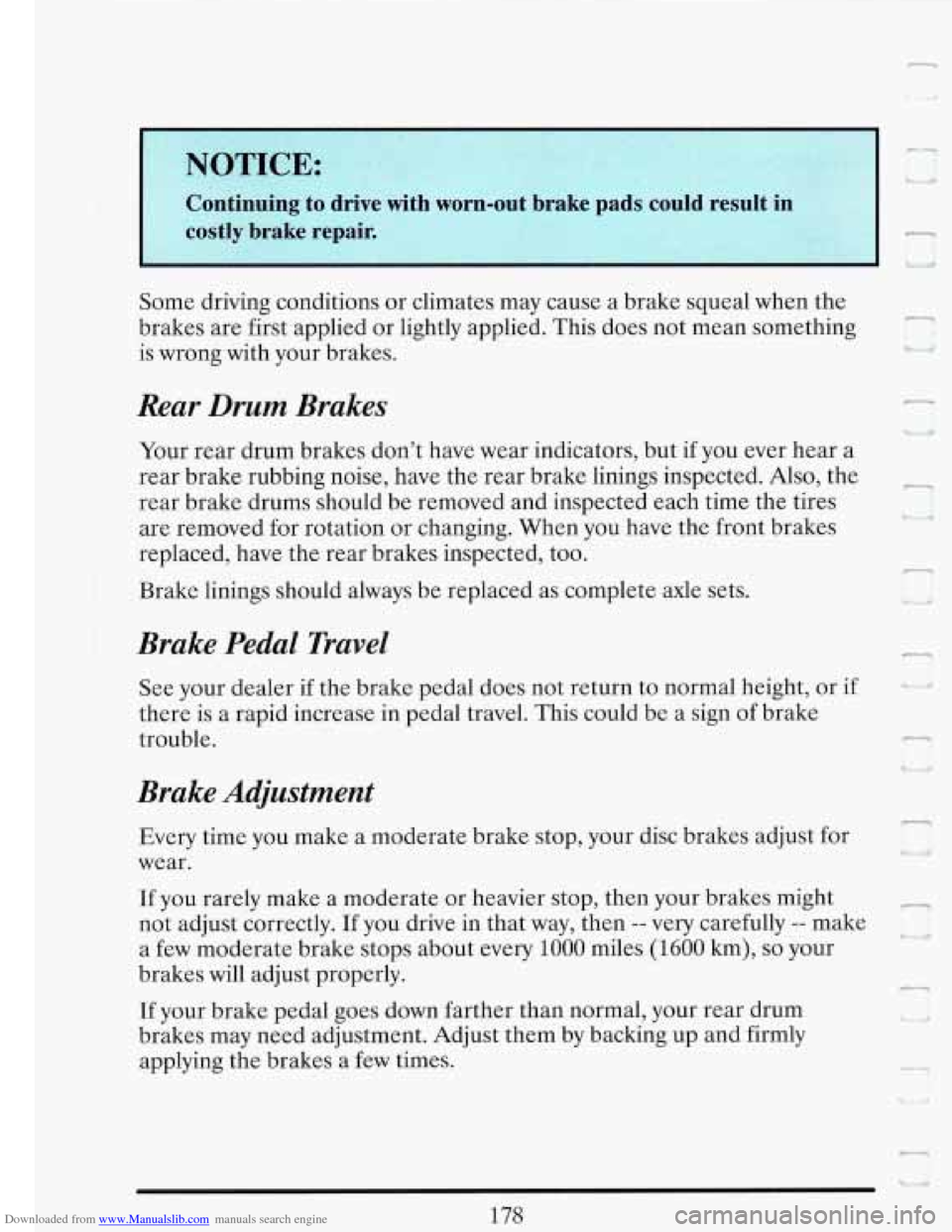
Downloaded from www.Manualslib.com manuals search engine IY OTICE:
-I
1
L
Continuing to drive with worn-out brake pads could result in
costly brake repair.
-
Some driving conditions or climates may cause a brake squeal when the
brakes are first applied or lightly applied. This does not mean something
is wrong with your brakes.
Rear Drum Brakes
F
c I
Your rear drum brakes don’t have wear indicators, but if you ever hear a
rear brake rubbing noise, have the rear brake linings inspected.
Also, the
rear brake drums should be removed and inspected each time the tires
are removed for rotation or changing. When you have the front brakes
replaced, have the rear brakes inspected,
too.
11
Brake linings should always be replaced as complete axle sets.
Brake Pedal Travel
See your dealer if the brake pedal does not return to normal height, or if c r
there is a rapid increase in pedal travel. This could be a sign of brake
trouble.
Brake Adjustment
Every time you make a moderate brake stop, your disc brakes adjust for
wear.
If you rarely make a moderate or heavier stop, then your brakes might
not adjust correctly. If you drive in that way, then
-- very carefully -- make
a few moderate brake stops about every
1000 miles (1600 km), so your -i
brakes will adjust properly.
,
-1
If your brake pedal goes down farther than normal, your rear drum
brakes may need adjustment. Adjust them
by backing up and firmly
applying the brakes a few times.
7
Page 193 of 386
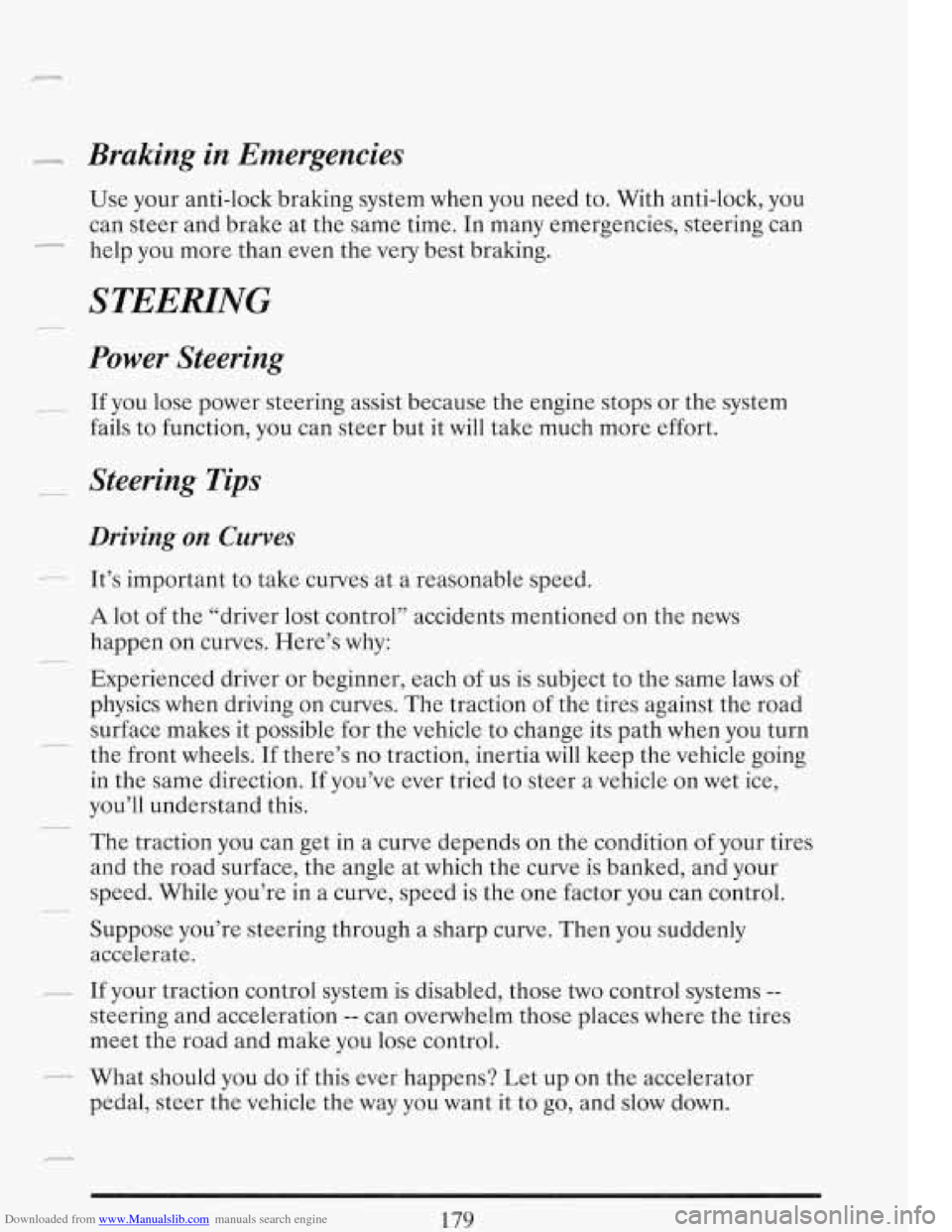
Downloaded from www.Manualslib.com manuals search engine Braking in Emergencies
Use your anti-lock braking system when you need to. With anti-lock, you
can steer and brake at the same time. In many emergencies, steering can
help you more than even the very best braking.
STEERING
Power Steering
If you lose power steering assist because the engine stops or the system
fails to function, you can steer but it will take much more effort.
Steering Tips
Driving on Curves
It’s important to take curves at a reasonable speed.
A lot of the “driver lost control” accidents mentioned on the news
happen on curves. Here’s why:
Experienced driver
or beginner, each of us is subject to the same laws of
physics when driving on curves. The traction
of the tires against the road
surface makes it possible for the vehicle to change its path when you turn
the front wheels. If there’s no traction, inertia
will keep the vehicle going
in the same direction. If you’ve ever tried to steer
a vehicle on wet ice,
you’ll understand this.
The traction you can get in a curve depends on the condition
of your tires
and the road surface, the angle at which the curve is banked, and your
speed. While you’re in a curve, speed is the
one factor you can control.
Suppose you’re steering through a sharp curve. Then you suddenly
accelerate.
If your traction control system
is disabled, those two control systems --
steering and acceleration -- can overwhelm those places where the tires
meet the road and make you lose control.
What should you do if this ever happens? Let up on the accelerator
pedal, steer the vehicle the way you want it to go, and slow down.
179
Page 198 of 386
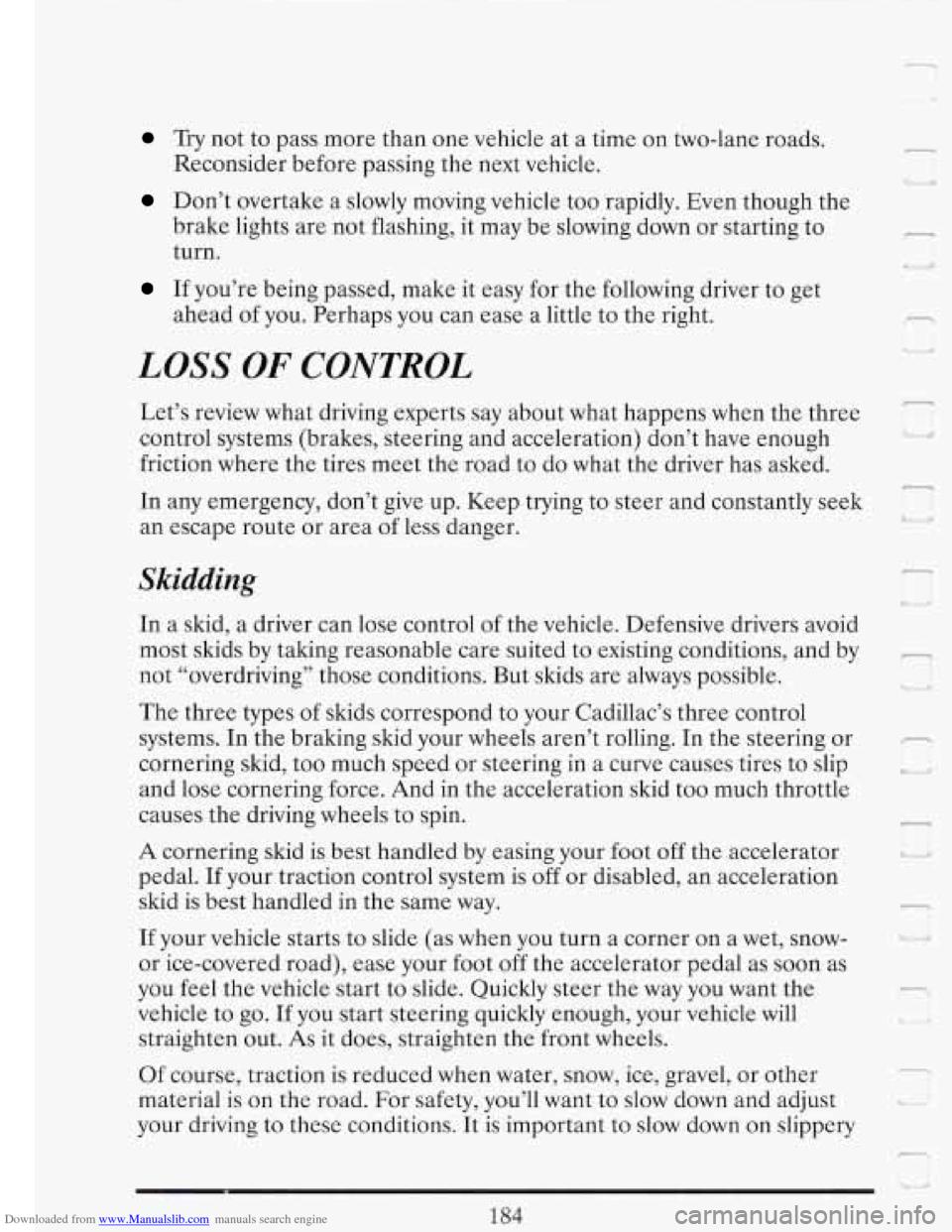
Downloaded from www.Manualslib.com manuals search engine Try not to pass more than one vehicle at a time on two-lane roads.
Reconsider before passing the next vehicle.
Don’t overtake a slowly moving vehicle too rapidly. Even though the
brake lights are
not flashing, it may be slowing down or starting to
turn.
If you’re being passed, make it easy for the following driver to get
ahead
of you. Perhaps you can ease a little to the right.
LOSS OF CONTROL
i
r
I/ U
Let’s review what driving experts say about what happens when the three
control systems (brakes, steering and acceleration) don’t have enough
’; I I
friction where the tires meet the road to do what the driver has asked.
r
In any emergency, don’t give up. Keep trying to steer and constantly seek
an escape route or area
of less danger.
-
le
Skidding
In a skid, a driver can lose control of the vehicle. Defensive drivers avoid
most skids by taking reasonable care suited to existing conditions, and by
._
not “overdriving” those conditions. But skids are always possible. < .,
The three types of skids correspond to your Cadillac’s three control
systems. In the braking skid your wheels aren’t rolling.
In the steering or
cornering skid, too much speed or steering in a curve causes tires to slip
and lose cornering force. And in the acceleration skid too much throttle
causes the driving wheels to spin.
A cornering skid is best handled by easing your foot off the accelerator
pedal.
If your traction control system is off or disabled, an acceleration
skid is best handled in the same way.
If your vehicle starts to slide (as when you turn a corner on a wet, snow-
or ice-covered road), ease your foot off the accelerator pedal as soon as
you feel the vehicle start to slide. Quickly steer the way you want the
vehicle to
go. If you start steering quickly enough, your vehicle will
straighten out.
As it does, straighten the front wheels.
Of course, traction is reduced when water, snow, ice, gravel, or other
material is on the road. For safety, you’ll want to slow down and adjust
your driving to these conditions. It is important to slow down on slippery
Lj
il t
1
-.
184